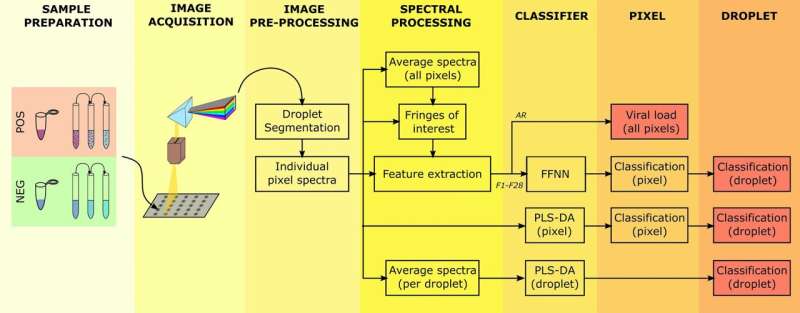Block diagram of proposed processing platform for classification (positive or negative) of fluid samples with lentiviral particles and quantification of their viral load. Fluid samples are deposited on a supporting plate and imaged (as liquid droplets and dry residues) in the visible and near-infrared ranges using a hyperspectral camera. Optical diffuse reflectance spectra are obtained and processed from individual pixels and averaged. Spectral (wavelength) fringes of interest are determined for the calculation of 29 morphological descriptors of features of individual spectra (F1–F28) and the area ratio (AR) with respect to the spectrum of the background. Two independent classifiers are constructed and evaluated –using the same training and test sample groups– at the pixel and sample (droplet) levels: a partial least square discriminant analysis (PLS-DA) of individual and droplet-averaged spectra and an artificial feed-forward neural network (FFNN) built on the values of the descriptors of features of individual spectra. Credit: DOI: 10.1038/s41598-021-95756-3
Researchers from the Universidad de Sevilla (University of Seville) have developed and patented a prototype to detect remotely viruses (including synthetic SARS-CoV-2) deposited on surfaces, analyzing images taken at multiple wavelengths—the so-called hyperspectral imaging—a technique commonly used in astrophysics. Astronomers from Calar Alto and IAA-CSIC have participated in the reduction and analysis of the spectra. The research is ongoing on human samples of coronavirus.
A group of researchers based in Spain and, particularly, in Andalusia, has designed a new optical technique allowing them to detect the presence of viruses in drops of fluids or in dry residuals spread over a surface. The work is led by Prof. Emilio Gómez-González, full professor of applied physics at ETS Engineering School at Universidad de Sevilla. The research, sponsored by the Institute of Health "Carlos III," has resulted in a patented technique able to analyze simultaneously numerous samples, without the need to touch them nor to use reagents.
The new technique is based on hyperspectral image stacking, that is, images taken at multiple wavelengths in the visible and near-infrared ranges. As well as processing them through advanced statistics algorithms and artificial intelligence. It has been applied to detect two types of synthetic viruses, usually taken as models for SARS-CoV-2 (synthetic lentiviruses and coronaviruses), in two fluids (saline solution and artificial saliva). The results of these works is being published today in Scientific Reports. The researchers keep working actively on the analysis of human samples of SARS-CoV-2.
The method is based on hyperspectral imaging, recently used to detect pathogens, mainly bacteria and fungi, in the farming industry and biology. Nevertheless, the present work goes further on, developing and extending this technology to the health sector, so as to detect viruses through an innovative and complex processing. To sum up, the system registers images of the samples arranged in a matrix and determines the positions in which the virus is detected as well as its concentration.
More information: Emilio Gomez-Gonzalez et al, Hyperspectral image processing for the identification and quantification of lentiviral particles in fluid samples, Scientific Reports (2021). DOI: 10.1038/s41598-021-95756-3
Journal information: Scientific Reports
Provided by University of Seville























